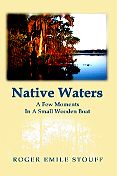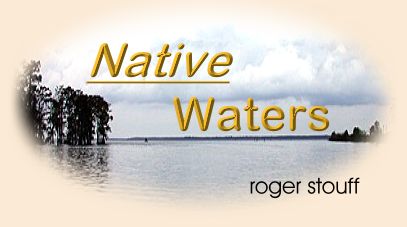|
(Editor's Note: This is the first in a series of columns
on Roger Stouff making the second of two episodes of Fly
Fishing America with Black-feet Indian Joe Kipp of Montana.)
The week of my second appearance as a fish-ing celebrity
- har, har, hee, hee - started on a bit of a flat note,
and despite the best efforts of all involved, improved
little, although there were moments of resonance.
I spent the entire weekend preparing for the arrival of Joe
Kipp, my Blackfeet Indian cousin and the film crew from Fly
Fishing America. You should understand that we're not cousins
so far as family ties except in the sense that all Natives
are family. In that family circle are cousins, brothers,
sisters, grandmothers and grandfathers, aunts and uncles.
Friday's weather forecast was dismal at best: A cold front
would push through the area Tuesday, bringing heavy rains
and a temperature drop of 20 degrees. That left us only
Monday and Tuesday to get some good footage. What originally
began as a four-day film shoot had been cut in half.
I spent Saturday working line onto new reels, getting the
boats ready, organizing fly boxes. I found to my dismay
that both trolling motor batteries in the big boat were
mysteriously shorted out and had to be replaced, a tab I
had not anticipated and would rather not have endured.
I had collected a nice assortment of salt-water flies,
as we intended to do one day of freshwater fishing for bass,
sac-au-lait and blue-gill, and a second day of marsh fishing
for redfish and speckled trout.
Sunday morning Joe Kipp called from the airport in Great
Falls, Montana to let me know there was no ticket for him
at the airport. Joe was scheduled to arrive in Lafayette
at 4:30 Sunday evening and I would have picked him up there.
But the travel agent had apparently made a colossal error
and, after quite a bit of wrangling by the film company,
the best that could be done was to have Joe into Lafayette
by 9 p.m. on Monday. This effectively meant Joe and I had
one day of potential fishing on film left.
But the crew arrived Sunday and we met for breakfast Monday
morning to hammer out a plan. Bryant, Jake and Aaron were
great, professional folks who, thankfully, have been at
this game of filming outdoors programs long enough to know
that sometimes the fish bite, sometimes they don't. That
doesn't do much to make a film, of course, but the facts
remain solid. Jake was the only familiar face: He had been
one of the videographers on my Blackfeet fishing trip.
We decided that we'd go to the lake, with me fishing without
Joe, for the afternoon. First we spent some time in Franklin,
though, so the crew could do what they call "B-roll" footage
of the area, the backstory, so to speak. They took lots of
film of Franklin's antebellum homes and historic district,
downtown, Sterling Sugars sugar-cane mill and the like before
we headed out to the Rez.
Chitimacha Tribal Chairman Al LeBlanc gave a brief welcome to
the crew on film, then we launched at the reservation boat
landing. My pal Francis Todd generously volunteered to carry
half the film crew in his boat while I had one guy with me
in my boat. We fished the cove all after-noon and, as expected,
it rained on us a little and the fish were slow to respond. I
had asked the crew several times if they had packed their rain
gear before we left, and all, including the skipper of the
camera boat, assured me they had. So when it started raining
everybody donned rain gear, except the guy who made sure they
all brought it, who had completely forgotten his in the truck,
and I got a little wet.
Since Hurricane Rita, the cove's water levels have decreased
six or eight inches, making an already shallow situation worse.
I could tell by the various pilings, duck blinds or sunken
logs that have been there for decades, by which I usually
gauge the water level, that I had lost at least six inches
of depth by sediment being pushed into the cove by the hurricane.
The cove faces northeast, the direction of the storm's winds,
and its back end goes nowhere, so all that sediment just churned
into the cove and settled out there when the wind and water
subsided. There were watermarks on the trees three and a half
feet up the cypress trunks.
We fished the cove from front to back and back up, and I managed
one small bass and a perch so tiny I slung him over the bow of
the boat when I set the hook! But the cove was beautiful, just
turning its fall colors, and the guys were able to get some truly
stunning video of my native waters before we called it quits and
headed home. It did give me the opportunity to talk about the
problems the hurricanes visited on the lake and the basin as
a whole, a little plug for conservation practices and a better
understanding of hurricane impact. Later, when we hit the marsh,
I also had an opportunity to talk about coastal land loss and
the importance of Louisiana's marshes and wetlands to the
entire nation.
That night we had supper at Café Bayou at the casino and I
went into Lafayette to pick up Joe Kipp at the airport. We
had a pleasant ride back to town, stopping in New Iberia for
a fishing license for my guest, a brief trip through the Rez
and then back to the motel where I dropped him off. We'd meet
up at 6 a.m. Tuesday to head for the marsh. ~ Roger
 It's out! And available now! You can be one of the
first to own a copy of Roger's book. Native Waters: A
Few Moments in a Small Wooden Boat
It's out! And available now! You can be one of the
first to own a copy of Roger's book. Native Waters: A
Few Moments in a Small Wooden Boat
Order it now from
www.iuniverse.com, Amazon.com,
or Barnes & Noble.com.
Roger will also be giving away three autographed copies to
readers. Stay tuned, for an announcement on the Bulletin
Board on that soon.
|


 It's out! And available now! You can be one of the
first to own a copy of Roger's book. Native Waters: A
Few Moments in a Small Wooden Boat
It's out! And available now! You can be one of the
first to own a copy of Roger's book. Native Waters: A
Few Moments in a Small Wooden Boat